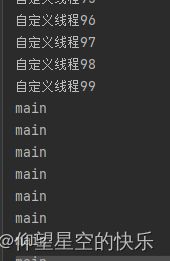线程基本方法
1。设置线程名
继承Thread类的线程,可以直接使用.setName()方法,设置线程名。也可以使用构造方法,需要注意java默认不继承构造方法,所以需要自己调用下父类的构造方法。
public class Demo {
public static void main(String[] args) {
MyThread myThread1=new MyThread("飞机");
myThread1.start();
MyThread myThread2=new MyThread();
myThread2.setName("火箭");
myThread2.start();
//当jvm虚拟机启动后,会自动的启动多条线程,其中一条是main主线程
//主线程的作用是调用main方法,并执行其中的代码,在以前,我们写的所有代码,其实都是运行在main线程中
Thread thread=Thread.currentThread();
System.out.println(thread.getName());
//获取优先级
System.out.println(myThread1.getPriority());
//线程的默认优先级都是5,包括main线程
}
}public class MyThread extends Thread {
@Override
public void run() {
for (int i = 0; i < 100; ++i) {
try {
Thread.sleep(1000);
} catch (InterruptedException e) {
e.printStackTrace();
}
//在不设置线程名的情况下,线程名默认是Thread+线程序号
System.out.println(getName());
}
}
//构造方法子类默认不继承,所以这里需要通过super关键字调用父类Thread的构造方法,给Thread设置名字
public MyThread() {
}
public MyThread(String name) {
super(name);
}
}实现runnable接口的线程,可以使用.setName方法。但是不能使用构造方法,因为他不像上面继承Thread类的线程,他没有父类的构造方法可以调用。
public class Mythread implements Runnable {
@Override
public void run() {
for (int i = 0; i < 100; ++i) {
String name = Thread.currentThread().getName();
System.out.println("你好世界!"+"----"+name);
}
}
}public class Demo {
public static void main(String[] args) {
Mythread mythread=new Mythread();
Thread t1=new Thread(mythread);
t1.setName("线程1");
Thread t2=new Thread(mythread);
t2.setName("线程2");
t1.start();
t2.start();
//获取优先级
System.out.println(t1.getPriority());
}
}2. join方法 当前线程需要等待 调用join方法的线程执行完毕,当前线程才能继续执行
public class Demo {
public static void main(String[] args) throws InterruptedException {
MyThread myThread = new MyThread();
myThread.start();
// 在默认情况下,当前线程和在当前线程添加的线程会交替执行
// 使用了join方法后,当前线程会等待myThread执行完毕,后继续执行本线程
myThread.join();
for (int i = 0; i < 10; i++) {
Thread.sleep(1);//模拟主线程执行耗时
System.out.println(Thread.currentThread().getName());
}
}
}public class MyThread extends Thread {
@Override
public void run() {
for (int i = 0; i < 100; ++i) {
try {
Thread.sleep(1000);
} catch (InterruptedException e) {
e.printStackTrace();
}
System.out.println("自定义线程"+i);
}
}
}执行结果:MyThread执行完后,才执行main线程的输出语句
3。
setDaemon
守护线程:当其他非守护线程执行完毕,守护线程不管是否执行完毕,都会停止。
就像舔狗(守护线程)和女神(非守护线程),如果女神走了,那舔狗啥都不管,也走。
主线程
public class Demo {
public static void main(String[] args) {
NvShenThread nvShenThread=new NvShenThread();
TianGouThread tianGouThread =new TianGouThread();
//将舔狗线程设置为守护线程 守护线程:当其他非守护线程执行完毕,会自动停止守护线程
//应用场景:qq聊天和发送文件,聊天框关闭,发送文件也应当停止
tianGouThread.setDaemon(true);
nvShenThread.start();
tianGouThread.start();
}
}
女神线程(非守护线程)
public class NvShenThread extends Thread {
@Override
public void run() {
for (int i = 0; i < 10; i++) {
try {
Thread.sleep(2);
} catch (InterruptedException e) {
e.printStackTrace();
}
System.out.println("女神线程执行"+"----"+i);
}
}
}舔狗线程(守护线程)
public class TianGouThread extends Thread {
@Override
public void run() {
for (int i = 0; i < 100; i++) {
try {
Thread.sleep(1);
} catch (InterruptedException e) {
e.printStackTrace();
}
System.out.println("舔狗线程执行"+"----"+i);
}
}
}